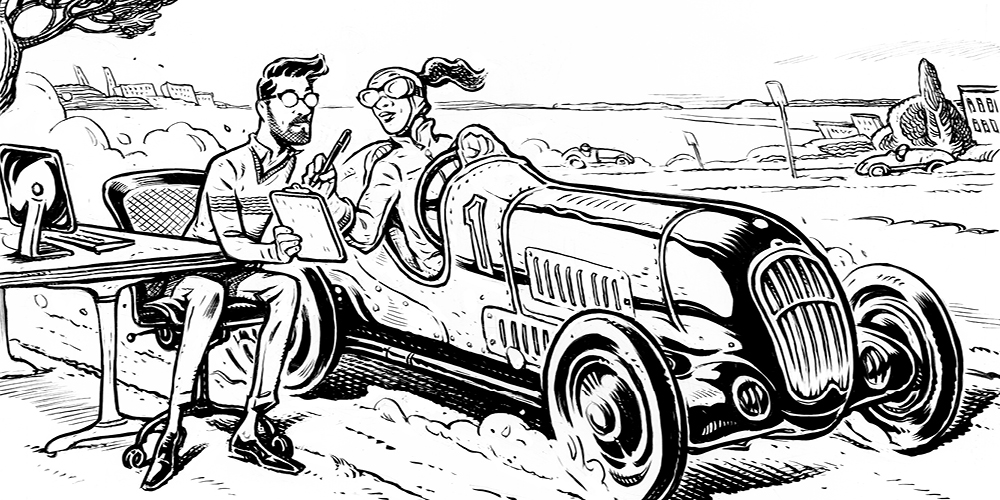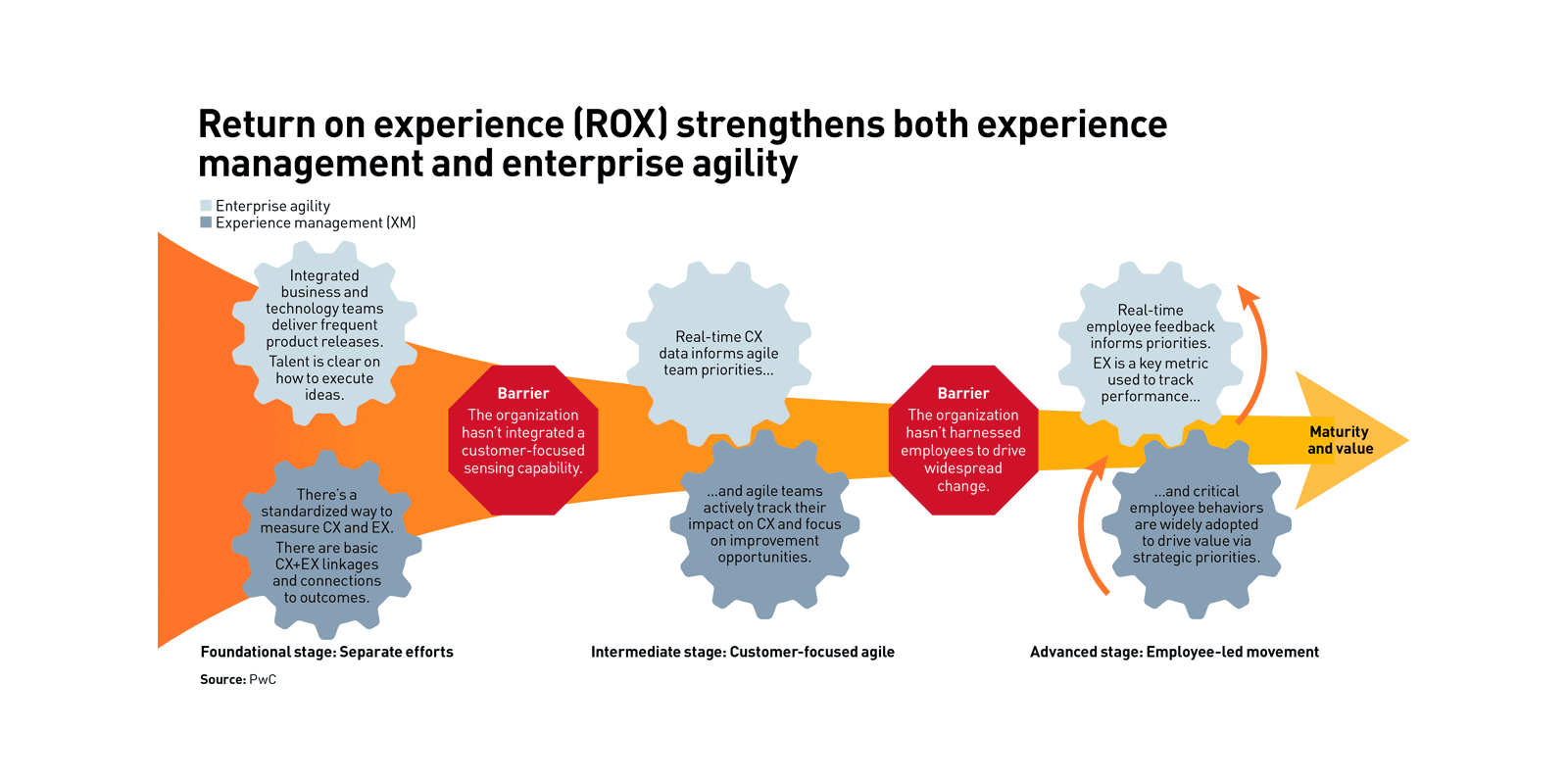Enterprise agility and experience management efforts work best when they work together
Many companies achieve early wins with separate transformational efforts, then stall. But if combined and enhanced using “return on experience,” or ROX, measures, these two programs can unlock each other’s potential.
A version of this article appeared in the Winter 2020 issue of strategy+business.
The leaders of the financial firm’s business transformation had reason to be proud. They’d been getting good results in their efforts to embed agile methods in the company’s operations. In the credit card contact center, for instance, they’d slashed the trouble ticket backlog by 97 percent in the first year of their initiative and reduced training time for new hires from five days to less than two.
Yet the leaders had found it difficult to scale agile across the entire organization. They struggled to identify, prioritize, and activate the program’s highest-value applications after their initial success. And they were no better at consistently and comprehensively measuring the impact of the opportunities they did pursue.
Enterprise agility was not the only initiative to run aground at the firm. The chief customer officer had been building an experience management (XM) discipline — tracking customer journeys, collecting data from customers and employees worldwide, and compiling findings so leaders could more readily identify, prioritize, and activate continuous improvement opportunities. But the firm struggled to scale XM across functions.
Over time, though, executives realized that there was synergy between their enterprise agility and experience management transformations. The two initiatives had been run like individually spinning gears, quickly turning out some results but lacking torque. Fitted together, they gave each other power and momentum. Insights and practices from experience management improved the leadership team’s ability to steer agile efforts, enhancing their impact. And enterprise agility helped leaders act on insights so they could improve experiences and extract value from their investments in building the XM discipline.
This synergy wasn’t a fluke. Companies in various industries are now realizing the reciprocal benefits of XM and agility programs. What’s giving them an extra push is ROX, or return on experience, a concept PwC initiated in 2019 with a framework, system of metrics, and activation engine. ROX helps companies center both agile and XM efforts on customer and employee experiences, enabling leaders to better direct their efforts and amplify their results.
Why breakthroughs are needed now
It’s never been more important than it is now to get the agile and XM gears locked together and running smoothly.
It’s never been more important than it is now to get the agile and XM gears locked together and running smoothly.
Like the financial firm in our example, many large companies have developed solid underpinnings in agile and in XM, and most of them have seen early gains. But, as with the example company, the elation has evaporated and the initiatives have bogged down. As many as two-thirds of firms that have launched agile efforts have struggled to scale them across their organizations, according to PwC research. And in our work with clients, we’ve seen that weaving XM methods into operations proves just as difficult.
But both efforts are now critical. Agile must succeed on a broad scale. In almost every industry, enterprise agility is vital to meeting rapidly changing customer needs and lowering operational costs, particularly across legacy organizational units, because its practices and technology enable organizations to pivot quickly from old to new priorities and ways of doing things. COVID-19 has made embedding this capability even more urgent than it already was.
XM initiatives can’t be allowed to stall, either. Organizations have more access to information about people than they’ve ever had before, and they must use it to improve experiences — driving continuous product design, technology enhancement, and process improvement — especially as COVID-19 amplifies changes in customers’ expectations and needsPDF. Also, remember that experience extends to employees. Anyone who’s ever encountered an unhelpful customer service representative or surly salesperson should recognize the connection between employee experience (EX) and customer experience (CX). And linked to both is leadership experience (LX), or the way in which organizations develop their leaders’ ability to solve problems and strategize.
Given that enterprise agility is, at its root, concerned with improved ways of working, the challenge for business leaders is how to tie it into those CX, EX, and LX connections, and how to realize value from them.
Two major barriers
Companies are already working on being more agile and improving experiences. So why aren’t we seeing explosions in organizational effectiveness everywhere?
To answer that question, it’s useful to break down the agility and XM disciplines by maturity level. We have observed three discrete stages — foundational, intermediate, and advanced — on the journey to the point at which the two disciplines become mutually beneficial and inextricable. At the foundational stage, the two initiatives are not yet working together; by the intermediate stage, they’ve been aligned; and at the advanced stage, the gears have been greased and the machine is running smoothly (see “Return on experience [ROX] strengthens both experience management and enterprise agility”).
Most organizations run into two major barriers along this path. The first is that they haven’t integrated a customer-focused sensing capability into the agile function to help them identify and prioritize the opportunities that will have the most impact. In such cases, CX might be measured and tracked in this or that customer interaction, but not across the entirety of the customer journey, not frequently enough, and not broadly enough. The effect of EX on agile efforts also isn’t considered often enough or to the extent needed for leaders to gain insights into how to enable good experiences for customers or measure how well agile methods are catching on. Nor is the effect of EX on good customer experiences measured.
The second common barrier prevents companies from realizing their full potential even after they have blended their XM and agile initiatives. In these organizations, real-time CX and EX data has started to inform agile team priorities, and agile teams have begun to track CX and EX impact and improvement opportunities. These organizations might have identified most of the “critical few” employee behaviors that matter most to improved experiences. But they’re still far from attaining a pervasive, company-wide agile culture or XM discipline, because they haven’t fully harnessed the power of their employees.
ROX: The key to removing the barriers
To push through these barriers, it’s crucial to know what lies beyond them. We believe that real maturity in both agile methods and XM will be evident in an employee-led “movement,” when real-time customer and employee experience signals inform agile team priorities, in turn making the XM program more actionable. Real maturity will be evident when EX and the adoption of the right employee behaviors are regularly applied as key metrics for tracking the performance of agile teams, and when the behaviors of agile leadership help drive value in strategic priorities such as innovation, safety, and sustainability. To get to this point, companies will have to uncover causal relationships among leading indicators, value drivers, and outcomes, building a model that shows how shifts in any one of those elements affect the others. ROX, the return on experience approach mentioned above, provides this model through a fast feedback loop enabled by enterprise agility.
Consider the case of an insurer selling auto and home policies. Let’s say analysis of the previous year’s customer experience and relevant operational data shows that speed of response to claims is the factor most likely to encourage holders of auto policies to renew. With that customer insight in hand, the agile team now knows that building agile approaches into claim operations will help unlock value. Measuring the experiences of those agile teams and scaling effective employee behaviors, both within the agile team and in employee interactions with customers, will further amplify the impact of the agile and XM efforts. So, the customer insights get the insurer past the first barrier to maturity by focusing the agile team on the most effective priorities, and then employee experience insights create a behavioral movement that gets the insurer past the second barrier to maturity.
What has to happen now
Companies that are struggling to scale their agile and XM models can take five specific actions now to get themselves on the path to real maturity, when both programs will be able to continuously connect experiences across customers, leaders, and employees.
Foster shared executive ownership of agile and experience management. The leaders of CX, EX, and agile capabilities should come together to build a joint governance and operating model that includes a coherent vision for the enterprise.
Plug any gaps in foundational agile and XM capabilities. The leaders responsible for driving enterprise agility and the XM discipline should assess their capability gaps. Addressing those gaps with a well-defined plan will help in evolving and integrating the two initiatives.
Integrate CX directly into each agile team to inform priorities. The agile transformation leader should build and deploy a customer-focused continuous improvement model by leveraging CX insights to identify, define, and prioritize opportunities.
Measure agile ways of working to enhance EX in agile teams. The leader of EX should deploy mechanisms (e.g., pulse surveys and behavior tracking) that measure the experience of employees in the agile pods, and the agile team leaders should act on those insights to further enhance ways of working.
Drive accountability for experience and operational improvement. The leaders of agile and XM should create clear roles within their teams to activate the experience improvement insights generated by combining data from the XM program (such as customer and employee feedback) with relevant operational data (such as behavioral insights).
The fusion of agile and XM disciplines doesn’t happen overnight in the best of organizations. It will present even more of a challenge for organizations that are only now developing real capabilities in both areas. But companies must aggressively pursue the organizational and cultural transformations needed to realize the full potential of that fusion. Every week, month, and quarter that a company struggles to scale its agile efforts and put experience at the forefront of its strategy is a week, month, or quarter of lost opportunity — time when a competitor may well be making the necessary moves.
Author profiles:
- Sujay Saha partners with clients to build capabilities and strategies that enhance customer and employee experiences, maximizing shareholder value while creating more customer-centered cultures, operating models, and organizational structures. He works in PwC’s customer strategy practice and is based in San Francisco, where he is a director with PwC US.
- Matt Egol is a leading practitioner in digital strategies for Strategy&, PwC’s strategy consulting business. Based in New York, he is a principal with PwC US. He works with B2B and B2C clients to help them accelerate the development of new disruptive strategies and capabilities for customer and employee experience.
- Matthew Siegel is an advisor to executives in people and organization strategies for Strategy&, PwC’s strategy consulting business. Based in New York, he is a principal with PwC US. He advises clients on organizational effectiveness, efficiency, and culture to improve execution against strategic priorities.





